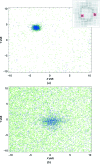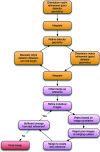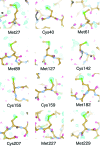A revised partiality model and post-refinement algorithm for X-ray free-electron laser data
- PMID: 26057680
- PMCID: PMC4461207
- DOI: 10.1107/S1399004715006902
A revised partiality model and post-refinement algorithm for X-ray free-electron laser data
Abstract
Research towards using X-ray free-electron laser (XFEL) data to solve structures using experimental phasing methods such as sulfur single-wavelength anomalous dispersion (SAD) has been hampered by shortcomings in the diffraction models for X-ray diffraction from FELs. Owing to errors in the orientation matrix and overly simple partiality models, researchers have required large numbers of images to converge to reliable estimates for the structure-factor amplitudes, which may not be feasible for all biological systems. Here, data for cytoplasmic polyhedrosis virus type 17 (CPV17) collected at 1.3 Å wavelength at the Linac Coherent Light Source (LCLS) are revisited. A previously published definition of a partiality model for reflections illuminated by self-amplified spontaneous emission (SASE) pulses is built upon, which defines a fraction between 0 and 1 based on the intersection of a reflection with a spread of Ewald spheres modelled by a super-Gaussian wavelength distribution in the X-ray beam. A method of post-refinement to refine the parameters of this model is suggested. This has generated a merged data set with an overall discrepancy (by calculating the R(split) value) of 3.15% to 1.46 Å resolution from a 7225-image data set. The atomic numbers of C, N and O atoms in the structure are distinguishable in the electron-density map. There are 13 S atoms within the 237 residues of CPV17, excluding the initial disordered methionine. These only possess 0.42 anomalous scattering electrons each at 1.3 Å wavelength, but the 12 that have single predominant positions are easily detectable in the anomalous difference Fourier map. It is hoped that these improvements will lead towards XFEL experimental phase determination and structure determination by sulfur SAD and will generally increase the utility of the method for difficult cases.
Keywords: free-electron laser; partiality; post-refinement.
Figures








References
-
- Adams, P. D. et al. (2010). Acta Cryst. D66, 213–221. - PubMed
-
- Barends, T. R. et al. (2013). Acta Cryst. D69, 838–842. - PubMed
-
- Boutet, S. et al. (2012). Science, 337, 362–364. - PubMed
-
- Brehm, W. & Diederichs, K. (2014). Acta Cryst. D70, 101–109. - PubMed
-
- Decker, F.-J. (1995). AIP Conf. Proc. 333, 550.
Publication types
MeSH terms
Associated data
- Actions

